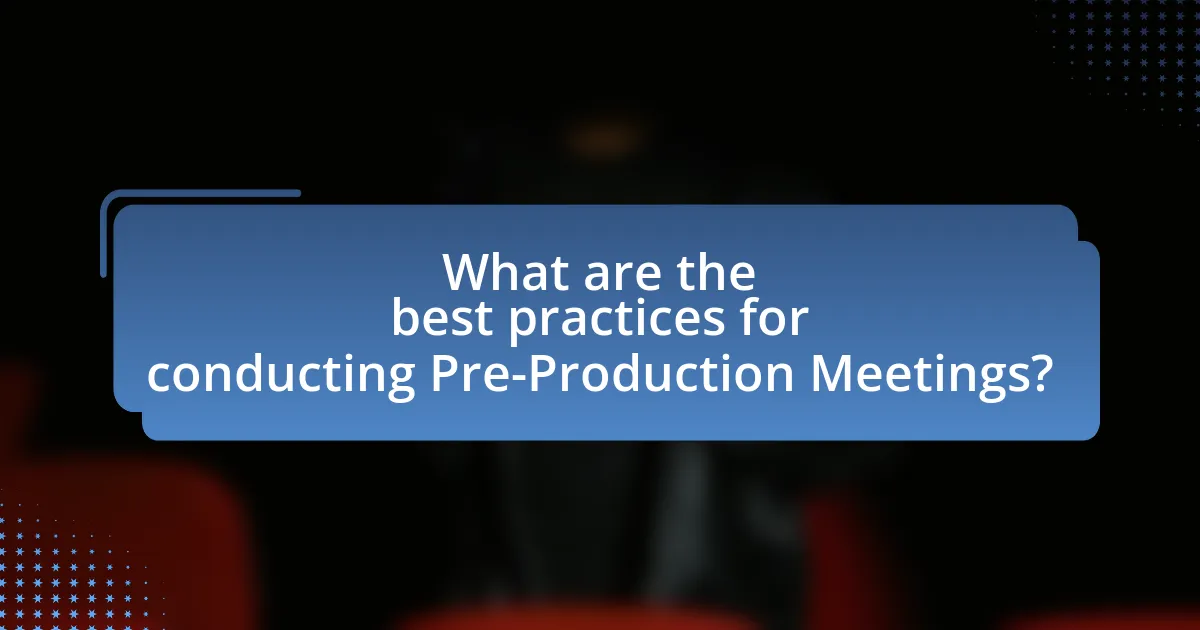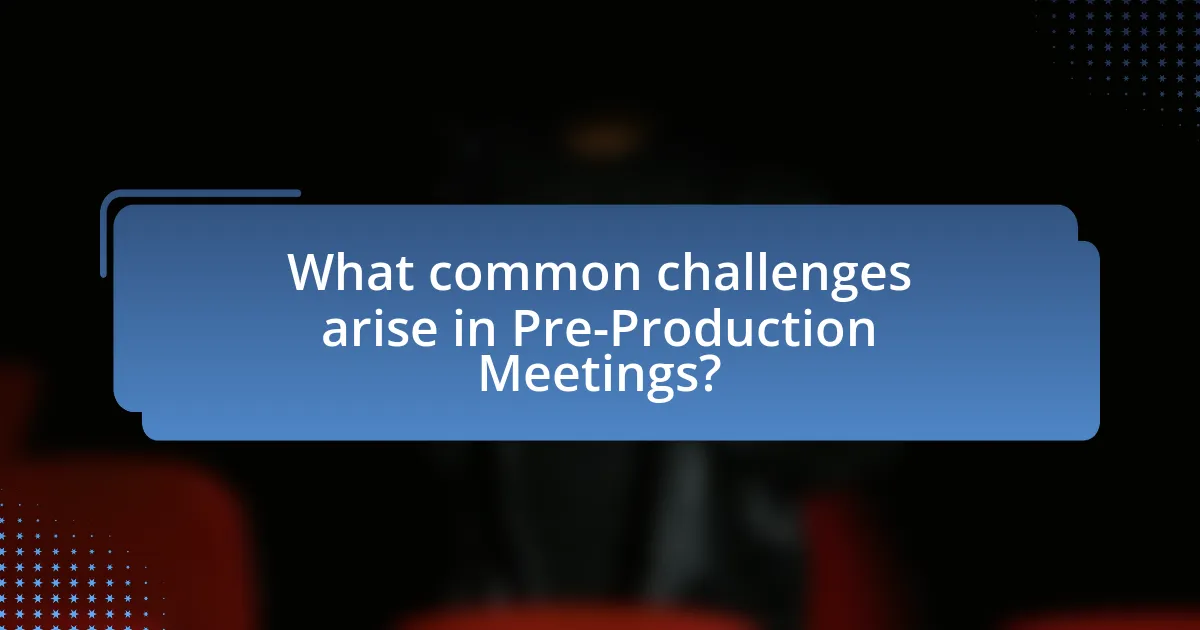Pre-production meetings are critical discussions held prior to the production phase in film, television, or theater, aimed at aligning the creative team, production staff, and stakeholders on project objectives, logistics, and responsibilities. These meetings cover essential topics such as scheduling, budgeting, casting, and technical requirements, fostering effective communication and collaboration among team members. Key stakeholders, including directors, producers, and department heads, participate to ensure all aspects of the production are addressed, minimizing misunderstandings and delays. Best practices for conducting these meetings include setting clear agendas, encouraging open communication, and preparing relevant materials, which collectively enhance project outcomes and team efficiency.

What are Pre-Production Meetings?
Pre-production meetings are organized discussions that take place before the actual production of a project, primarily in film, television, or theater. These meetings aim to align the creative team, production staff, and stakeholders on the project’s vision, logistics, and responsibilities. They typically cover essential topics such as scheduling, budgeting, casting, and technical requirements, ensuring that all parties have a clear understanding of their roles and the project’s objectives. The effectiveness of pre-production meetings is supported by industry practices that emphasize thorough planning to minimize issues during production, ultimately leading to a smoother workflow and successful project outcomes.
How do Pre-Production Meetings fit into the production process?
Pre-production meetings are essential components of the production process as they establish clear communication and alignment among team members. These meetings allow stakeholders to discuss project goals, timelines, and responsibilities, ensuring everyone is on the same page before production begins. By addressing potential challenges and clarifying expectations, pre-production meetings significantly reduce the risk of miscommunication and delays during the actual production phase. Research indicates that effective communication in project management can lead to a 20-25% increase in project success rates, highlighting the importance of these meetings in fostering collaboration and efficiency.
What are the key objectives of Pre-Production Meetings?
The key objectives of Pre-Production Meetings are to establish clear communication among team members, align on project goals, and identify potential challenges. These meetings facilitate the sharing of critical information, ensuring that all stakeholders understand their roles and responsibilities. By discussing timelines, budgets, and creative visions, teams can proactively address issues and streamline the production process. Research indicates that effective communication in pre-production significantly enhances project outcomes, reducing the likelihood of costly delays and misunderstandings.
Who should be involved in Pre-Production Meetings?
Pre-production meetings should involve key stakeholders such as the director, producer, production manager, and department heads including cinematography, art, sound, and costume. These individuals are essential as they provide insights and expertise necessary for planning and executing the project effectively. Their involvement ensures that all aspects of the production are aligned, facilitating clear communication and collaboration among the team.
Why are Pre-Production Meetings important for effective communication?
Pre-production meetings are crucial for effective communication because they establish a clear understanding of project goals, roles, and expectations among team members. These meetings facilitate the alignment of creative visions and logistical plans, ensuring that everyone involved is on the same page. Research indicates that projects with well-defined communication strategies, such as those developed in pre-production meetings, experience a 20% increase in efficiency and a 30% reduction in misunderstandings, leading to smoother workflows and better outcomes.
How do these meetings enhance team collaboration?
Pre-production meetings enhance team collaboration by fostering open communication and aligning team goals. These meetings provide a structured environment where team members can share ideas, clarify roles, and address potential challenges, leading to a more cohesive approach to project execution. Research indicates that effective communication in teams can improve project outcomes by up to 25%, as it reduces misunderstandings and increases accountability among team members.
What role does clear communication play in the success of a project?
Clear communication is essential for the success of a project as it ensures that all team members understand their roles, responsibilities, and the project’s objectives. When communication is clear, it minimizes misunderstandings and errors, leading to more efficient workflows and timely completion of tasks. Research indicates that projects with effective communication practices are 20% more likely to succeed, as highlighted in the Project Management Institute’s “Pulse of the Profession” report. This report emphasizes that clear communication fosters collaboration, enhances problem-solving, and ultimately drives project success.

What are the best practices for conducting Pre-Production Meetings?
The best practices for conducting Pre-Production Meetings include setting a clear agenda, ensuring all key stakeholders are present, and fostering open communication. A clear agenda helps participants understand the meeting’s objectives and stay focused, while the presence of key stakeholders ensures that all necessary perspectives are considered. Open communication encourages team members to share ideas and concerns, which can lead to more effective planning and problem-solving. Research indicates that effective communication in meetings can enhance team collaboration and project outcomes, as highlighted in studies on team dynamics and project management.
How can you prepare for a successful Pre-Production Meeting?
To prepare for a successful Pre-Production Meeting, create a detailed agenda that outlines key discussion points and objectives. This agenda should be distributed to all participants in advance to ensure everyone is aligned on the topics to be covered. Additionally, gather all relevant materials, such as scripts, storyboards, and production schedules, to facilitate informed discussions. Research shows that meetings with clear agendas and prepared participants are 73% more effective in achieving their goals, as indicated by a study from the Harvard Business Review.
What materials and information should be gathered beforehand?
Gather a detailed project brief, including objectives, timelines, and budget constraints, as well as a list of team members and their roles. This information is essential for aligning the team’s understanding and expectations. Additionally, collect any relevant research materials, such as market analysis or competitor insights, to inform decision-making. Having these materials ensures that all participants are prepared to contribute effectively and that discussions are focused and productive.
How can setting an agenda improve meeting effectiveness?
Setting an agenda improves meeting effectiveness by providing a clear structure and focus for discussions. This structured approach ensures that all relevant topics are covered within a designated timeframe, reducing the likelihood of digressions and unproductive conversations. Research indicates that meetings with a defined agenda can increase participant engagement and accountability, as attendees are aware of the topics to be discussed and can prepare accordingly. Additionally, a study published in the Harvard Business Review found that meetings with agendas are 20% more productive than those without, highlighting the tangible benefits of this practice in enhancing overall meeting outcomes.
What techniques can facilitate effective communication during these meetings?
Active listening, clear agenda setting, and visual aids are techniques that can facilitate effective communication during pre-production meetings. Active listening ensures that all team members feel heard and valued, which fosters a collaborative environment. Setting a clear agenda prior to the meeting helps to keep discussions focused and on track, reducing the likelihood of misunderstandings. Utilizing visual aids, such as charts or slides, can enhance comprehension and retention of information, making it easier for participants to engage with the material presented. These techniques are supported by research indicating that structured communication methods improve team collaboration and project outcomes.
How can active listening be encouraged among team members?
Active listening can be encouraged among team members by implementing structured communication practices, such as regular feedback sessions and active engagement techniques. These practices create an environment where team members feel valued and understood, which is essential for fostering active listening. Research indicates that teams that engage in structured feedback report a 25% increase in communication effectiveness, as measured by team performance metrics. Additionally, training sessions focused on active listening skills can enhance awareness and practice, leading to improved interpersonal dynamics within the team.
What tools can be used to enhance communication during meetings?
Video conferencing platforms such as Zoom and Microsoft Teams can enhance communication during meetings by providing real-time visual and audio interaction. These tools facilitate remote participation, allowing team members to engage from different locations, which is crucial for effective collaboration. According to a study by the International Journal of Information Management, video conferencing can improve team dynamics and decision-making processes by fostering a sense of presence and engagement among participants. Additionally, collaborative tools like Slack and Trello support ongoing communication and project management, ensuring that all team members are aligned and informed throughout the meeting process.

What common challenges arise in Pre-Production Meetings?
Common challenges in Pre-Production Meetings include miscommunication, lack of clarity in roles, and insufficient preparation. Miscommunication often leads to misunderstandings about project goals and expectations, which can derail the production process. A lack of clarity in roles can result in overlapping responsibilities or tasks being neglected, causing delays. Insufficient preparation, such as not having necessary materials or information ready, can hinder effective discussions and decision-making. These challenges can significantly impact the overall efficiency and success of the production.
How can misunderstandings be minimized during discussions?
Misunderstandings can be minimized during discussions by actively listening and clarifying points of confusion. Active listening involves fully concentrating on the speaker, which helps in accurately interpreting their message. Clarifying questions, such as “Can you elaborate on that point?” or “Did you mean…?” ensure that all participants share a common understanding. Research indicates that effective communication techniques, including summarizing and paraphrasing, significantly reduce misinterpretations. For instance, a study published in the Journal of Business Communication found that teams employing these techniques experienced a 30% decrease in misunderstandings.
What strategies can be employed to address conflicts within the team?
To address conflicts within the team, implementing open communication, active listening, and conflict resolution training are effective strategies. Open communication fosters an environment where team members feel safe to express their concerns, which can prevent misunderstandings from escalating into conflicts. Active listening ensures that all parties feel heard and valued, promoting empathy and understanding. Conflict resolution training equips team members with the skills to navigate disagreements constructively, leading to quicker and more effective resolutions. Research indicates that teams with strong communication practices experience 25% fewer conflicts, highlighting the importance of these strategies in maintaining a harmonious work environment.
How can time management issues be resolved in meetings?
Time management issues in meetings can be resolved by setting clear agendas and time limits for each discussion point. Establishing an agenda ensures that all participants are aware of the topics to be covered, which helps to keep the meeting focused and on track. Research indicates that meetings with a defined agenda can reduce meeting time by up to 30%, as participants are less likely to deviate from the planned topics. Additionally, assigning a timekeeper can help monitor the duration of discussions, ensuring that each topic receives appropriate attention without exceeding the allotted time. This structured approach not only enhances productivity but also respects participants’ time, leading to more efficient meetings.
What are the consequences of ineffective Pre-Production Meetings?
Ineffective Pre-Production Meetings lead to miscommunication, project delays, and increased costs. When team members do not clearly understand their roles or the project’s objectives, it results in confusion and errors during production. According to a study by the Project Management Institute, poor communication is a primary factor in project failure, contributing to 57% of project overruns. Additionally, lack of alignment on goals can cause teams to work at cross purposes, further exacerbating inefficiencies and wasting resources.
How can poor communication impact project outcomes?
Poor communication can significantly hinder project outcomes by leading to misunderstandings, delays, and decreased team morale. When team members lack clear information, they may misinterpret tasks or objectives, resulting in errors that require rework. A study by the Project Management Institute found that ineffective communication is a primary contributor to project failure, with 57% of project managers citing it as a key issue. Additionally, poor communication can create a lack of trust among team members, further complicating collaboration and reducing overall productivity.
What lessons can be learned from failed Pre-Production Meetings?
Failed Pre-Production Meetings highlight the importance of clear communication, thorough preparation, and defined roles within a team. These meetings often fail due to a lack of agenda, which leads to disorganized discussions and unresolved issues. For instance, a study by the Project Management Institute found that 39% of project failures are attributed to poor communication. Additionally, unclear objectives can result in misaligned expectations, causing delays and increased costs. By analyzing these failures, teams can implement structured agendas, ensure all members understand their responsibilities, and foster an environment where open dialogue is encouraged, ultimately improving the effectiveness of future meetings.
What practical tips can improve your Pre-Production Meetings?
To improve your Pre-Production Meetings, establish a clear agenda that outlines topics to be discussed and objectives to be achieved. This structured approach ensures that all participants are prepared and focused, leading to more productive discussions. Research indicates that meetings with a defined agenda can increase efficiency by up to 30%, as participants can prioritize their contributions and stay on track. Additionally, encourage open communication by fostering an environment where team members feel comfortable sharing ideas and feedback, which enhances collaboration and creativity.
How can follow-up actions be effectively communicated post-meeting?
Follow-up actions can be effectively communicated post-meeting by sending a concise summary email that outlines the key decisions made, assigned tasks, and deadlines. This method ensures clarity and accountability, as it provides all participants with a written record of what was discussed and agreed upon. Research indicates that written communication enhances retention of information, with studies showing that people remember only 10% of what they hear, but up to 65% of what they read (Source: “The Forgetting Curve,” Hermann Ebbinghaus). Additionally, using project management tools to track tasks and deadlines can further reinforce accountability and facilitate ongoing communication among team members.
What role does feedback play in refining future meetings?
Feedback is essential in refining future meetings as it provides insights into participants’ perceptions and experiences. By collecting feedback, organizers can identify areas for improvement, such as agenda clarity, time management, and participant engagement. Research indicates that organizations that actively seek and implement feedback see a 20% increase in meeting effectiveness, as reported by the Harvard Business Review. This data underscores the importance of feedback in enhancing communication and collaboration within teams during pre-production meetings.


